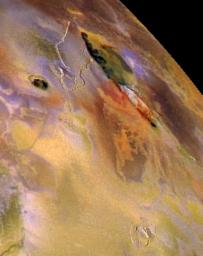
|
Zal Patera, Io, in color
- Click the image above for a larger view
- Full-Res JPEG (712 x 900) (75.3 kB)
- Full-Res TIFF (712 x 900) (2.0 MB)
Caption:
The Zal Patera region of Jupiter's volcanic moon Io is shown in this combination of high-resolution black and white images taken by NASA's Galileo spacecraft on November 25, 1999 and lower resolution color images taken by Galileo on July 3, 1999. By combining both types of images, Galileo scientists can better understand the relationships between the different surface materials and the underlying geologic structures. For example, in the center toward the top of the picture, the edge of the caldera, or volcanic crater, is marked by the black flows, and it coincides with the edge of a plateau. Also, the red material (just above and to the right of the center of the image) is typically associated with regions where lava is erupting onto the surface. Here the red material follows the base of a mountain, which may indicate that sulfurous gases are escaping along a fault associated with the formation of the mountain.
Scientists can use the lengths of the shadows cast to estimate the height of the mountains. They estimate that the northernmost plateau, which bounds the western edge of Zal Patera, rises up to approximately 2 kilometers (6,600 feet) high. The mountain to the south of the caldera has peaks up to approximately 4.6 kilometers (15,000 feet) high, while the small peak at the bottom of the picture is approximately 4.2 kilometers (14,000 feet) high.
North is to the top of the image, which is centered at 33.7 degrees north latitude and 81.9 degrees west longitude. The higher resolution images have a sharpness of about 260 meters (or yards) per picture element, and they are illuminated from the left. These images were taken on November 25, 1999 at a range of 26,000 kilometers (16,000 miles). The color images are illuminated from almost directly behind the Galileo spacecraft. The resolution of the color images is 1.3 kilometers (0.8 miles) per picture element. They were taken on July 3, 1999 at a distance of about 130,000 kilometers (81,000 miles).
Background Info:
The Jet Propulsion Laboratory, Pasadena, CA manages Galileo for NASA's Office of Space Science, Washington, DC. JPL is a division of the California Institute of Technology, Pasadena, CA.
This image and other images and data received from Galileo are posted on the Galileo mission home page at http://solarsystem.nasa.gov/galileo/ . Background information and educational context for the images can be found at http://galileo.jpl.nasa.gov/gallery/io.cfm .
Cataloging Keywords:
| Name | Value | Additional Values |
|---|---|---|
| Target | Io | |
| System | Jupiter | |
| Target Type | Satellite | |
| Mission | Galileo | |
| Instrument Host | Galileo Orbiter | |
| Host Type | Orbiter | |
| Instrument | Solid-State Imaging (SSI) | |
| Detector | ||
| Extra Keywords | Color, Crater, Mountain, Shadow, Volcano | |
| Acquisition Date | ||
| Release Date | 2000-03-06 | |
| Date in Caption | 1999-07-03 | 1999-11-25 |
| Image Credit | NASA/JPL/University of Arizona | |
| Source | photojournal.jpl.nasa.gov/catalog/PIA02527 | |
| Identifier | PIA02527 | |
